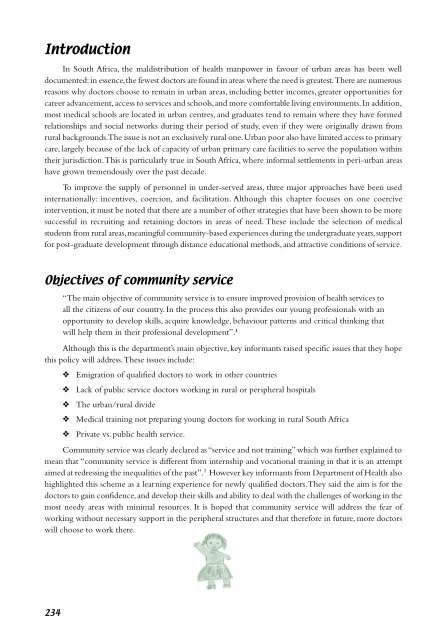Monitoring the implementation of community service
Monitoring the implementation of community service
Monitoring the implementation of community service
You also want an ePaper? Increase the reach of your titles
YUMPU automatically turns print PDFs into web optimized ePapers that Google loves.
Introduction<br />
In South Africa, <strong>the</strong> maldistribution <strong>of</strong> health manpower in favour <strong>of</strong> urban areas has been well<br />
documented: in essence, <strong>the</strong> fewest doctors are found in areas where <strong>the</strong> need is greatest. There are numerous<br />
reasons why doctors choose to remain in urban areas, including better incomes, greater opportunities for<br />
career advancement, access to <strong>service</strong>s and schools, and more comfortable living environments. In addition,<br />
most medical schools are located in urban centres, and graduates tend to remain where <strong>the</strong>y have formed<br />
relationships and social networks during <strong>the</strong>ir period <strong>of</strong> study, even if <strong>the</strong>y were originally drawn from<br />
rural backgrounds. The issue is not an exclusively rural one. Urban poor also have limited access to primary<br />
care, largely because <strong>of</strong> <strong>the</strong> lack <strong>of</strong> capacity <strong>of</strong> urban primary care facilities to serve <strong>the</strong> population within<br />
<strong>the</strong>ir jurisdiction. This is particularly true in South Africa, where informal settlements in peri-urban areas<br />
have grown tremendously over <strong>the</strong> past decade.<br />
To improve <strong>the</strong> supply <strong>of</strong> personnel in under-served areas, three major approaches have been used<br />
internationally: incentives, coercion, and facilitation. Although this chapter focuses on one coercive<br />
intervention, it must be noted that <strong>the</strong>re are a number <strong>of</strong> o<strong>the</strong>r strategies that have been shown to be more<br />
successful in recruiting and retaining doctors in areas <strong>of</strong> need. These include <strong>the</strong> selection <strong>of</strong> medical<br />
students from rural areas, meaningful <strong>community</strong>-based experiences during <strong>the</strong> undergraduate years, support<br />
for post-graduate development through distance educational methods, and attractive conditions <strong>of</strong> <strong>service</strong>.<br />
Objectives <strong>of</strong> <strong>community</strong> <strong>service</strong><br />
234<br />
“The main objective <strong>of</strong> <strong>community</strong> <strong>service</strong> is to ensure improved provision <strong>of</strong> health <strong>service</strong>s to<br />
all <strong>the</strong> citizens <strong>of</strong> our country. In <strong>the</strong> process this also provides our young pr<strong>of</strong>essionals with an<br />
opportunity to develop skills, acquire knowledge, behaviour patterns and critical thinking that<br />
will help <strong>the</strong>m in <strong>the</strong>ir pr<strong>of</strong>essional development”. 1<br />
Although this is <strong>the</strong> department’s main objective, key informants raised specific issues that <strong>the</strong>y hope<br />
this policy will address. These issues include:<br />
❖ Emigration <strong>of</strong> qualified doctors to work in o<strong>the</strong>r countries<br />
❖ Lack <strong>of</strong> public <strong>service</strong> doctors working in rural or peripheral hospitals<br />
❖ The urban/rural divide<br />
❖ Medical training not preparing young doctors for working in rural South Africa<br />
❖ Private vs. public health <strong>service</strong>.<br />
Community <strong>service</strong> was clearly declared as “<strong>service</strong> and not training” which was fur<strong>the</strong>r explained to<br />
mean that “<strong>community</strong> <strong>service</strong> is different from internship and vocational training in that it is an attempt<br />
aimed at redressing <strong>the</strong> inequalities <strong>of</strong> <strong>the</strong> past”. 2 However key informants from Department <strong>of</strong> Health also<br />
highlighted this scheme as a learning experience for newly qualified doctors. They said <strong>the</strong> aim is for <strong>the</strong><br />
doctors to gain confidence, and develop <strong>the</strong>ir skills and ability to deal with <strong>the</strong> challenges <strong>of</strong> working in <strong>the</strong><br />
most needy areas with minimal resources. It is hoped that <strong>community</strong> <strong>service</strong> will address <strong>the</strong> fear <strong>of</strong><br />
working without necessary support in <strong>the</strong> peripheral structures and that <strong>the</strong>refore in future, more doctors<br />
will choose to work <strong>the</strong>re.

















